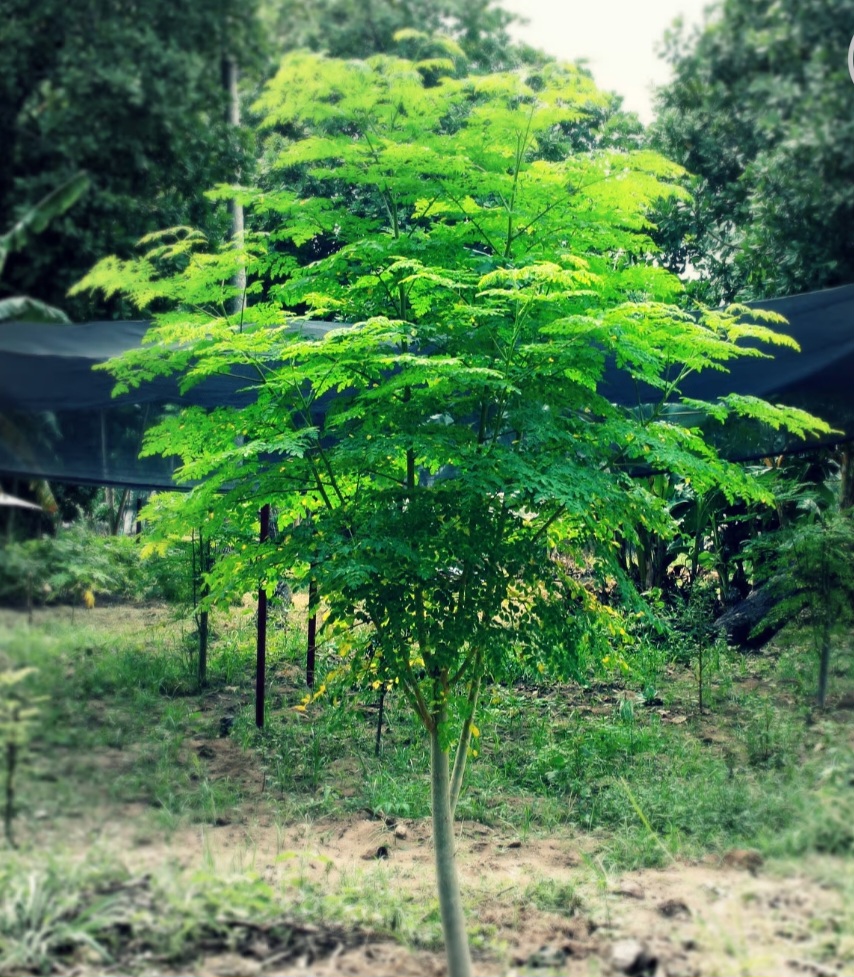
Moringa oleifera is a fast-growing, drought-resistant tree of the family Moringaceae. It thrives globally in almost all tropical and subtropical regions. It is native to Northern India and used extensively in South and Southeast Asia. It is called by common name such as moringa, drumstick tree, (from the long, slender, triangular seed-pods), horseradish tree (from the taste of the roots, which resembles horseradish), or malunggay (as known in Tagalog, maritime or archipelagic areas in Asia), Indian ben (English); ben oléifère, ben ailée, moringa ailée, pois quénique (French), marango, resedá, árbol de rábano, árbol de los espárragos (Spanish); acácia-branca, muringueiro, quiabo-da-quina, maranga, paraíso, paraíso blanco [Portuguese]; Meerrettichbaum (German); zogale [Hausa]; kelor [Indonesian]; mlonge (Swahili); chùm ngây [Vietnamese]; ሽፈራው (Amharic); بان زيتوني (Arabic); সজনে [Bengali]; ဒန့်သလွန် (Burmese); 辣木 (Chinese); מורינגה מכונפת (Hebrew); सहजन (Hindi); ワサビノキ (Japanese); ನುಗ್ಗೆಕಾಯಿ (Kannada); മുരിങ്ങ (Malayalam); शेवगा (Marathi); ਸੁਹਾਂਜਣਾ (Punjabi); முருங்கை (Tamil); มะรุม (Thai). It is also called the “tree of life” or ” miracle tree”.
The Moringa family comprises of 13 species (M. oleifera, M. arborea, M. rivae, M. ruspoliana, M. drouhardii, M. hildebrandtii, M. concanensis, M. borziana, M. longituba, M. pygmaea, M. ovalifolia, M. peregrina, M. stenopetala), of which M. oleifera has become well known for its use in nutrition, biogas production, fertilizer, etc
Moringa contains proteins, vitamins, and minerals, making it useful to fight malnutrition. It is widely cultivated for its young seed pods and leaves.
PLANT DESCRIPTION
a. LEAVES: The tree or shrub is small to medium in size, the leaves are naturally trifoliate, alternate, 7-60 cm long, with each pinnate bearing 4-6 pairs of leaflets that are dark green, elliptical to obovate, and 1-2 cm in length.
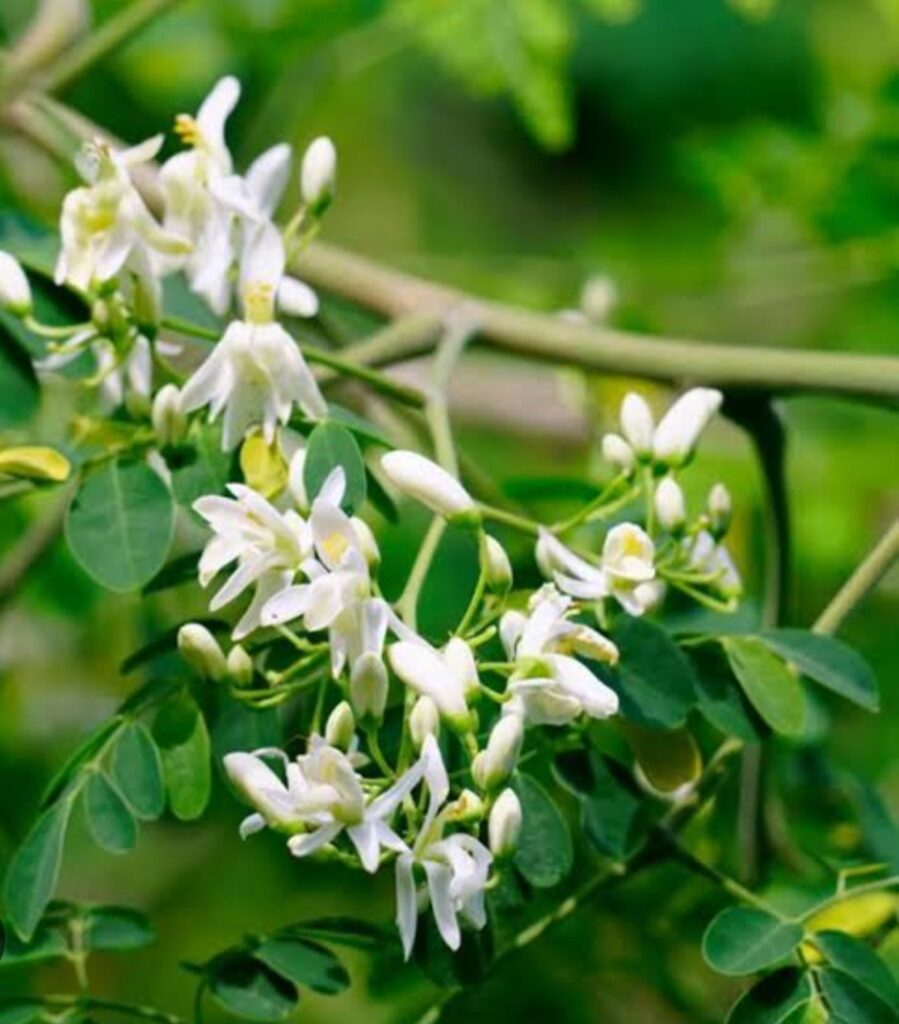
b. THE FLOWERS: The flowers are born on an inflorescence 10–25 cm long. Spreading panicles bearing many fragrant flowers. The flowers are pentamerous, zygomorphic, 7-14 mm long and white to cream in colour.
c. THE FRUIT: The fruits are usually trifoliate and commonly referred to as “pods”. They are 3-valved capsule, 10 to 60 cm in length, and looking like a drumstick (hence the name “drumstick tree”). The fruit is green when young and turns brown at maturity. The mature fruit splits open along each angle to expose the seeds. The capsule contains 15-20 rounded oily seeds, 1-1.5 cm in diameter surrounded by 3 papery wings, up to 2.5 cm long. Moringa seeds contain a large amount of oil.
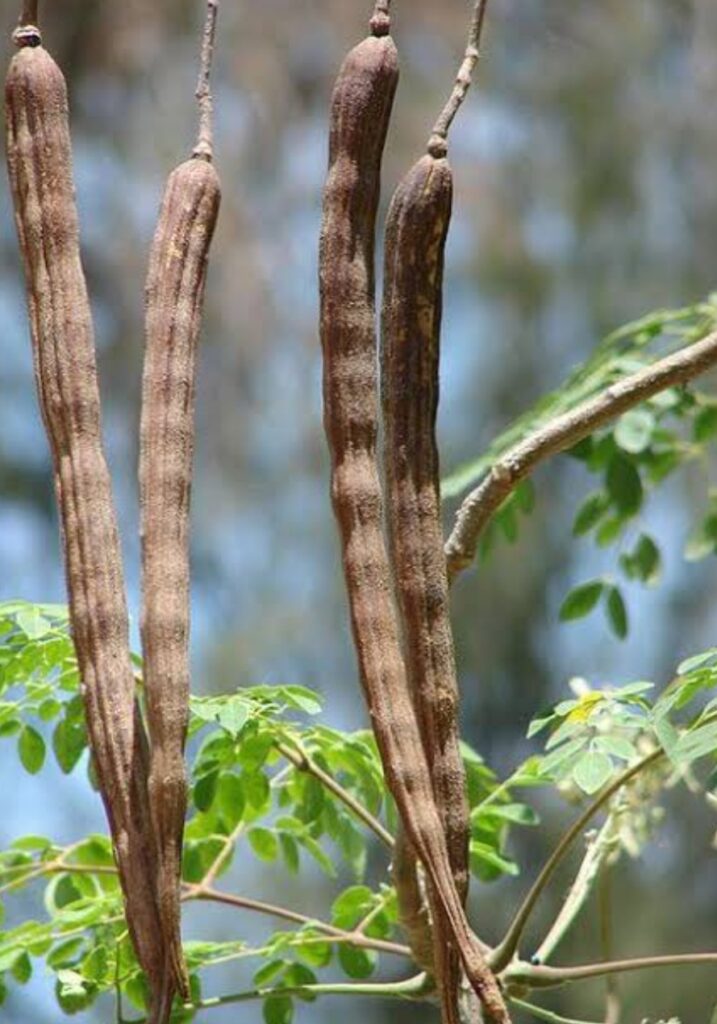
d. THE STEM: The trunk usually grows straight but is occasionally poorly formed, the branches are usually disorganized, the canopy is umbrella-shaped, with fragile and drooping branches, and feathery foliage. The bark is corky and grey, young twigs and shoots are covered in short dense hairs, purplish or greenish white in colour.
e. THE SEEDS: They are borne in a capsule or a semi-permeable hull. When dry, they turn brownish. and each tree has a capacity of producing about 15,000–25,000 seeds per year.
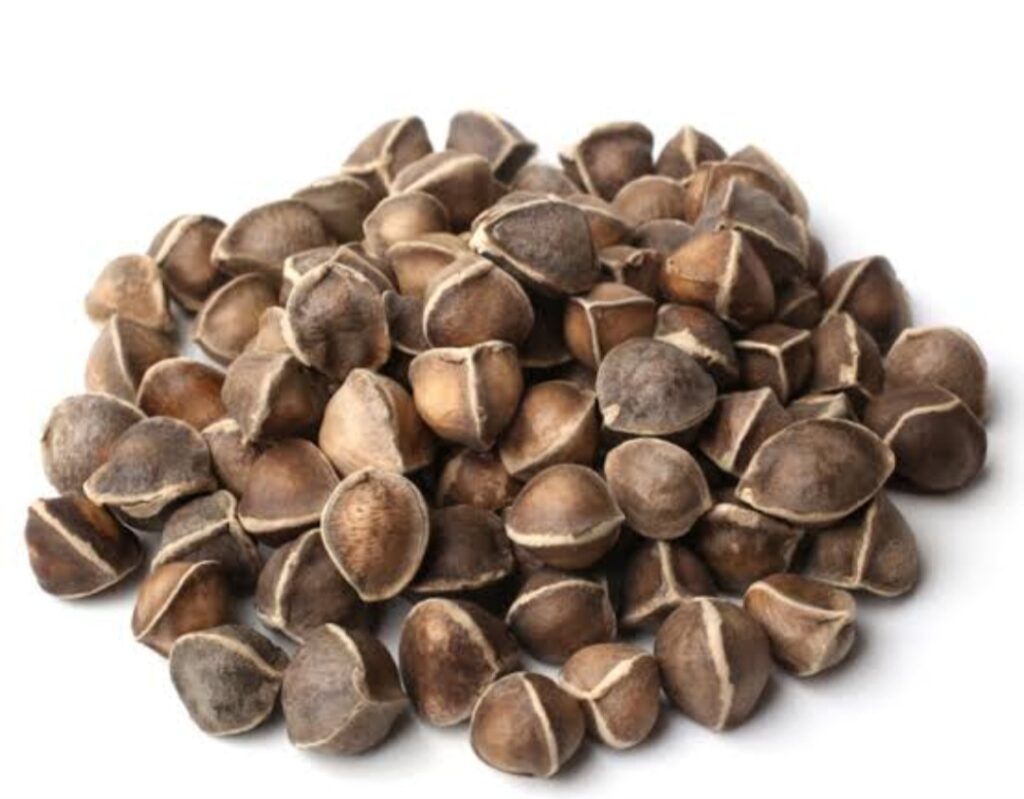
f. THE ROOTS: The roots are taproot which grows deep into the soil.
PHYTOCHEMICALS PRESENT IN DIFFERENT PLANT PART EXTRACTS OF M. oleifera.
a. ROOTS: Ethanolic and methanolic substances. Also in the root is an alkaloid called aurnatiamide acetate
b. LEAVES: Ethanolic, aqueous, methanolic , carotenoid and lutein. The leaves also contain about thirty-five compounds, among which are; palmitoyl chloride, cis-vaccenic acid, 5-O-acetyl-thio-octyl, pregna-7-dien-3-ol-20-one, γ-sitosterol, β-l-rhamnofuranoside, tetradecanoic acid, marumoside A and marumoside B,
c. SEEDS: Ethanolic, aqueous Seeds Chemicals like Alkaloid, Tannins, Flavonoids, Saponins, Terpenoids, Glycosides, Steroids, Coumarins, Proteins and Starch.
d. STEM: Moringin and moringinine are the two alkaloids present in the plant’s stem.
Apart from the above, M. oleifera is also a rich source of glucosinolates. The most abundant glucosinolate present in the species is 4-O-(α-L-rhamnopyranosyloxy)-benzyl glucosinolates, also known as glucomoringin.
A sterol isolate, β-sitosterol is found in the seeds and leaves. Another type of sterol glycoside β-sitosterol-3-O-β-D-galactopyranoside can be found at the bark of the plant.
Diterpenes and terpenes are found in the leaves. Among which Phytol is diterpene alcohol, a major component of chlorophyll, and is found abundantly in leaves of the plant. At the same time, terpenes and their derivatives are present in trace amounts (linalool oxide, farnsylacetone, isolongifolene α-ionene, and α- and β-ionone), whereas hexahydro-farnesyl acetone can be found in abundance.
Seed oil extract of M. oleifera commonly contains tannins and saponins. Also, fatty acids such as arachidic acid, octacosanoic acid, oleic acid, palmitic acid, stearic acid, linolenic acid, behenic acid, and paullinic acid are found in the plant seeds.
Two glycosides, namely niazirin and niazirinin are found in moringa.
The exudate of the gum is rich in poly saccharides such as D-galactose, L-arabinose, D-xylose, L-rhamnose, D-mannose, and -glucuronic acid.
BENEFITS OF MORINGA
Moringa oleifera is classified as an important herbal plant due to its immense medicinal and non-medicinal benefits.
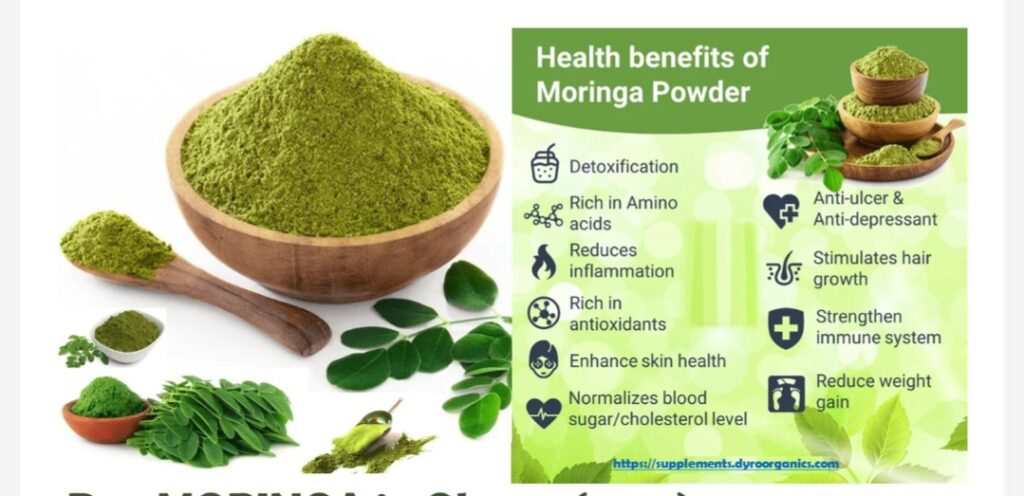
1. It is used as vegetables
2. It is used for traditional herbal medicine.
3. It is also used for water purification. The oil cake resulting from seed oil extraction contains about 1% of floculant proteins that bind mineral particles and organic material in the purification of drinking water.
4. Moringa is an important food source in some parts of the world. The immature green pods (drumsticks) are prepared similarly to green beans, while the seeds, when removed from more mature pods can be cooked like peas or roasted like nuts. The leaves can be cooked and used like spinach, and they are also dried and powdered for use as a condiment.
5. It can be grown cheaply and easily, and retains much of its nutritional value when dried. Its leaves contain more vitamin C than oranges and more calcium than milk, boosting the immune system and strengthening bones. They are also an excellent source of protein, aiding muscle growth and tissue repair. Moringa is rich in iron, combating fatigue, and potassium, supporting heart health. Its antioxidant and anti-inflammatory properties play a crucial role in protecting the body against various diseases.
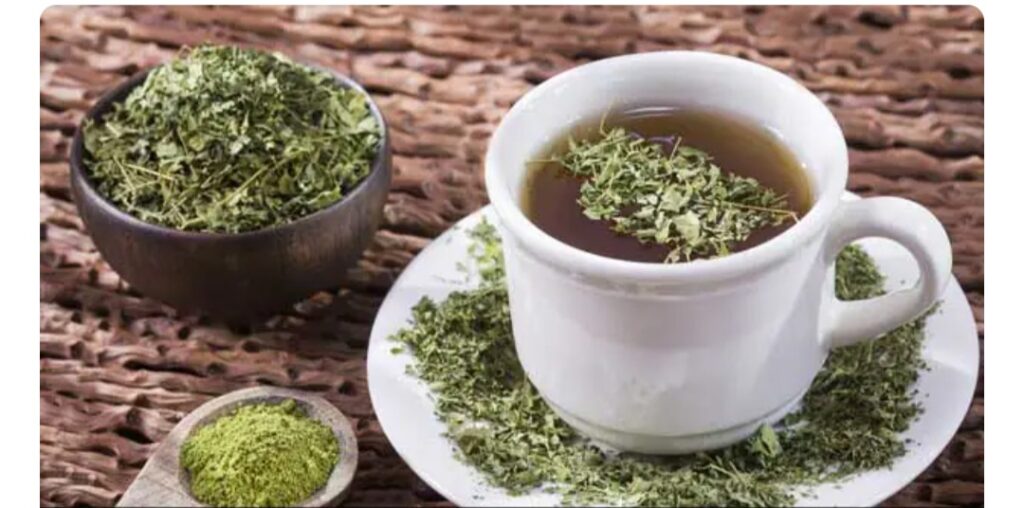
6. As an antioxidant, it seems to help protect cells from damage.
7. Moringa might also help decrease inflammation and reduce pain.
8. Moringa is used for asthma, diabetes, breast-feeding, and many other purposes, but there is no good scientific evidence to support these uses.
Research has shown that taking 3 grams of moringa twice daily for 3 weeks reduces the severity of asthma symptoms and improves lung function in adults with mild to moderate asthma.
8. The effect of moringa on diabetes control is unclear. Some early research shows that taking moringa tablets along with a type medicine called sulfonylureas does not improve blood sugar control as measured by hemoglobin A1C levels. But it does seem to reduce fasting and post-meal blood sugar levels compared to taking sulfonylureas alone in people with diabetes. Other research also shows that taking moringa drumstick leaves with meals might also reduce post-meal blood sugar levels in people with diabetes not taking medications for diabetes.
9. HIV/AIDS. Early research shows that taking moringa leaf powder with each meal for 6 months might increase body mass index (BMI) but does not appear to improve immune function.
10. Traditionally, the plant is used to cure wounds, pain, ulcers, liver disease, heart disease, cancer, and inflammation.
11. The pharmacological studies confirm the hepatoprotective, cardioprotective, and anti-inflammatory potential of the extracts from the various plant parts.
12. All parts of moringa plant contain bioactive constituents. Apart from this, it contains more than one hundred compounds located at its different parts. Such compunds include; alkaloids, flavonoids, anthraquinones, vitamins, glycosides, and terpenes.
13. In addition, novel isolates such as muramoside A and B and niazimin A and B have been identified in the plant and have potent antioxidant, anticancer, antihypertensive, hepatoprotective, and nutritional effects.
14. Studies have shown that M. oleifera is among the cheapest and most reliable alternatives for good nutrition .
15. Nearly all parts of the tree are used for their essential nutrients. M. oleifera leaves have a high content of beta-carotene, minerals, calcium, and potassium. The bark of the tree is considered very useful in the treatment of different disorders such as ulcers , toothache, and hypertension. Roots, however, are found to have a role in the treatment of toothache, helminthiasis, and paralysis. The flowers are used to treat ulcers, enlarged spleen, and to produce aphrodisiac substances.
16. The roots are conventionally used to treat kidney stones, liver diseases, inflammation, ulcers, and pain associated with the ear and tooth. The bark of the stem is used to treat wounds and skin infections.
17. Indians use the gum extracted from this plant to treat fever, and it is also used to induce abortions. The seeds of the plant act as a laxative and are used in the treatment of tumors, prostate, and bladder problems. The seeds show promise for the treatment of arthritis by altering oxidative stress and reducing inflammation. Preparations from the plant leaves benefit nursing mothers and malnourished infants and improve the general health of the population. The leaves have been useful for patients suffering from insomnia and treating wounds.
18. The dried leaves have an oleic acid content of about 70%, which makes them suitable for making moisturizers .
19. The powdered leaves are used to make many beverages, of which “Zija” is the most popular in India
20. The tree is believed to have incredible properties in treating malnutrition in infants and lactating mothers.
21. People worldwide have included M. oleifera in their diet since ancient times because of its vital therapeutic values. Various medicines made from the plant are said to have ethnomedicinal properties for curing diseases and have been used for centuries. Approximately every part (leaf, pod, bark, gum, flower, seed, seed oil, and root) of this plant has been used to treat one disease or another. It has being used in pathological alterations such as antihypertensive, anti-anxiety, anti-diarrheal, and as a diuretic.
Moringa is also used to treat dysentery and colitis. A poultice made from Moringa leaves is a quick remedy for inflammatory conditions such as glandular inflammation, headache, and bronchitis. The pods treat hepatitis and relieve joint pain.
22. Moringa is used extensively in the cosmetic industry nowadays, and in ancient Egyptian history, it was similarly used for preparing dermal ointments.
23. M. oleifera ethanolic root extract contains a compound N-benzylethyl thioformate (an aglycone of deoxyniazimincin) which is an antimicrobial and antifungal compund. It can be used to treat the effect of fungal and microbial disease infection.
M. oleifera methanolic leaf extract may exert inhibition of urinary tract infections caused by Gram-negative and Gram-positive bacteria such as Klebsiella pneumoniae, Staphylococcus aureus, Escherichia coli, and Staphylococcus saprophyticus.
The inhibitory effect of the extracts from the leaves, seeds, and stems have been specified in various fungal strains such as Aspergillus flavus, Aspergillus terreus, Aspergillus nidulans, Rhizoctonia solani, Aspergillus niger, Aspergillus oryzae, Fusarium solani, Penicillium sclerotigenum, Cladosporium cladosporioides, Trichophyton mentagrophytes, Penicillium species, Pullarium species.
24. M. oleifera seeds have active components like 4-(alpha-L-rhamanosyloxy) benzyl isothiocyanates, which are believed to also have antimicrobial properties . The juice of Moringa leaves also showed potential treatment against human pathogenic bacteria. The methanolic leaf extract has nearly 99% inhibition against Botrytis cinerea (a necrotrophic plant fungus).
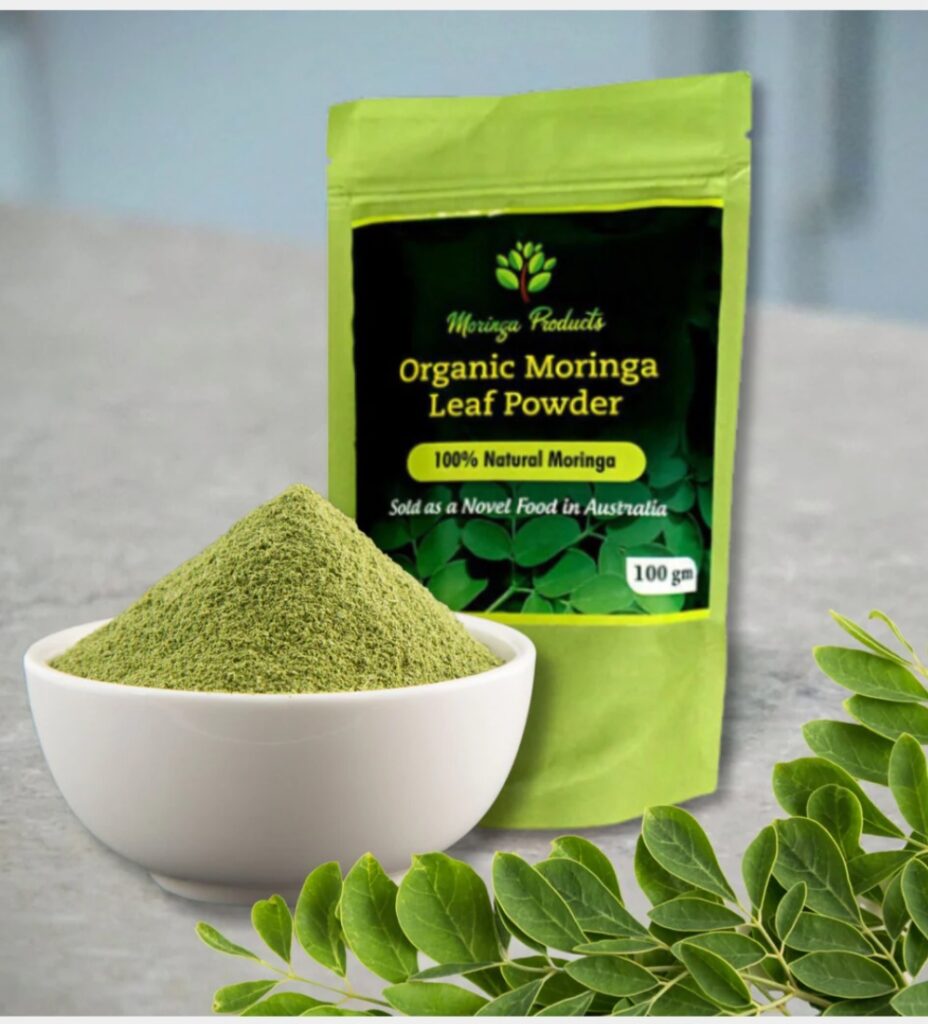
25. The fruit of M. oleifera contains alkaloids, flavonoids, and steroids, which have an inhibitory effect against the culture of Candida albicans by either denaturing the protein or inhibiting the germination of spores through the steroid ring they contain.
26. Strong inhibitory effects of moringa seed kernel extract were observed for Bacillus cereus, Staphylococcus aureus, Mucor species, and Aspergillus species. However, it was less effective against P. aeruginosa and E. coli. This indicated that, except for E. coli and P. aeruginosa, moringa seed kernel extract might be utilized to treat infections caused by these species.
A recent study has been conducted, which states that only apolar extract obtained from seeds of M. oleifera showed anti-microbial activity against Gram-positive bacteria.
27. The results of M. oleifera were observed in methotrexate-induced mice. The study aimed to look into a probable palliative effect of M. oleifera extract on mice. The mice received the extract one week before administering methotrexate injection, and this treatment was continued for 12 days. The result showed that pretreatment with an extract of M. oleifera on mice poisoned with methotrexate could protect them from oxidative stress.
28. The antioxidant activity of ethanolic extract M. oleifera stems exhibited a protective effect against epidermal oxidative stress injury induced by H2O2 in keratinocytes. The result displayed that the stems showed antioxidant potential, and, therefore, can be used as an excellent and preventive source in animal epidermal oxidative stress injury.
In addition, a research investigated the antioxidant potential of Moringa leaves against diclofenac sodium-induced liver toxicity in animals. The researchers concluded that the extract was significantly effective against diclofenac-induced liver toxicity and, therefore, can be considered liver protective.
29. Bioactive compounds such as glycosylates, isothiocyanates, thiocarbamates, flavonoids, and certain other compounds from Moringa pods have been investigated for reactive oxygen spices. The aqueous extract has been shown to be a potent free radical scavenger against free radicles. Previous studies suggest that the antioxidant potential might be due to kaempferol, which is mainly found in plant leaves. The synergistic outcome of Moringa was observed with piperine and curcumin on oxidative stress induced by beryllium toxicity in Wistar rats. The alcoholic extract of the plant reduced glucose-induced cataractogenesis in isolated goat eye lenses by controlling GSH levels. Myricetin, derived from the Moringa seed extract, has proved to be a better antioxidant than BHT (butylated hydroxytoluene) and alpha-tocopherol. M. oleifera leaf extract and compounds, such as isoquercetin, astragalin, and crypto-chlorogenic acid, help lower ROS in HEK-293 cells. Moringa is also helpful in reducing plasma monoaldehyde (MDA) levels in fasting plasma glucose (FPG) concentration in healthy volunteers compared to the individuals fed with warm water. A dose-dependent upsurge in GSH and reduced MDA levels were observed with alcoholic extract of the plant without toxic effect till 100 mg/kg.
30. Several parts of moringa (fruits, leaves, flowers, stems) have been shown to be beneficial against cancer, a deadly disease. The isolated compounds thiocarbamate and isothiocyanate from moringa act as inhibitors of tumor cells. The dichloromethane fraction was found to be cytotoxic for MCF7 breast cancer cells. Niazimincin has been projected as an effective chemopreventive agent in chemical carcinogenesis. Alcoholic and hydro-methanolic extracts of its fruits and leaves have shown significant tumor growth retardation in the melanoma mouse model. Soluble cold distilled water from Moringa inhibited tumor cell growth and reduced ROS (reactive oxygen species) in cancer cells.
Lastly, in a recent study based on computational modelling suggests that M. oleifera contains rutin with the highest binding affinity with BRAC-1 (Breast Cancer Gene-1) .
31. Adding to the list of beneficial effects of Moringa, the various parts of the plant possess fertility and abortion-inducing properties. The aqueous extract at a 200 and 400 mg/kg dose has been found to be more abortifacient and anti-fertility effects. Recent studies on hot and cold extracts of leaves of M. oleifera propose that ingestion of Moringa before, after, and during pregnancy may lead to adverse fetal developmental outcomes by causing rigorous contraction of the uterine wall .
32. Among the numerous flavonoids (quercetin, kaempferol, isoquercetin, rhamnetin, etc.,) present in Moringa, quercetin in Moringa flowers is thought to be accountable for the hepatoprotective effect. Methanolic extract at low dose showed changes in hepato-renal and hematological profile with significant changes in serum aminotransferase concentration, plasma cholesterol level, alkaline phosphate, bilirubin, and serum LPO levels. However, the higher dose of the extract altered total bilirubin, blood urea nitrogen, and non-protein nitrogen levels and decreased the clotting time.
Liver injuries induced by acetaminophen in Sprague-Dawley rats, where the standard drug taken was silymarin, Moringa showed similar hepatoprotective properties in these rats by dropping the levels of AST, ALT, and ALP. The seeds were also found to be effective against carbon tetrachloride-induced liver fibrosis, as evidenced by a reduction in serum aminotransferase activity and globulin levels. Treatment with this plant extract for about 21 days regularly as diet significantly reduced liver injury, and this effect was found due to alkaloid, quercetin, kaempferol, flavonoids, ascorbic acid, and benzyl glucosinolates in this plant.
33. Bisphenols and flavonoids found in moringa leaves showed a reduced level of ulcer index, duodenal ulcer, and stress ulcer in the ibuprofen-induced gastric ulcer model. Moringa extract was shown to significantly reduce free radicals and neutralize the acidic behavior of gastric juice and have a protective effect on the development of gastric ulcer. The presence of flavonoids in the plant has been shown to have a protective effect on ulcer formation by increasing capillary resistance and improving microcirculation, resulting in less cell injury.
34. Previous results have proved that leaves extract reestablishes levels of monoamine in the brain and is very helpful in Alzheimer’s disease, while the in vitro activity of the ethanolic extract of the leaves showed an anticonvulsant effect on dopamine and norepinephrine levels, locomotor activity, and serotonin (5HT) in the brain in penicillin-induced convulsions . The methanolic root extract in mice induced by pentobarbital sodium and diazepam has remarkable sedative effects on the CNS by improving sleep duration. The toluene acetate fraction of the methanolic extract proved its potency as a possible nootropic agent. The leaves have shown good anticonvulsant activity in a phenyl tetrazoline and maximal electric shock-induced model using male albino mice. The aqueous extract of the roots blocked the epileptic seizures induced by penicillin in adult albino rats. The ethanolic leaves extract exhibited anxiolytic properties, which were confirmed in behavioral experiments using the actophotometer and the rotarod device, respectively.
35. The broad spectrum of phytoconstituents of the leaves extract of Moringa has lead researchers to develop a herbal alternative for treating chronic neuropathic pain caused by constriction. The need to limit conventional analgesics for this disease. Diabetic rats inflicted with neuropathic pain caused by chronic constriction were used for the study. Tests conducted before and after treatment with moringa leaves showed that they significantly altered the neuropathic pain condition in diabetic rats. It suggests that the drop in oxidative stress might be the underlying mechanism in treating neuropathic pain and thus could be used as an effective novel source for the same.
36. A significant effect in studies on wound healing after incision or excision was demonstrated for ethyl acetate, and water extract of M. oleifera leaves at a 300 mg/kg dose. Studies reported that in preclinical studies, leaves, seeds, and dried pulp extracts have shown effective enhancement of wound closure, granuloma rupture strength, and reduction of skin rupture strength in the scar area. Leaf extracts have shown promising results in diabetic animals by improving the downregulation of inflammatory markers and increasing the vascular endothelial growth factor level in the injured tissue. Compounds present in aqueous extract have shown a considerable effect on diabetic foot ulcers by downregulating the levels of various inflammatory markers. The researcher conducted an in vitro assay to select the standardized extract with the highest potency, which was then converted into a film for wound healing. The result showed that the aqueous extract had the maximum cell proliferation and migration properties among the different extracts.
37. M. oleifera has demonstrated its significant benefits in hematological activities. A randomized, double-blind study suggests that aqueous leaf extract effectively improves women’s low hemoglobin levels (8–12 g/dL). Another study showed that M. oleifera leaves, when taken for 14 days by healthy volunteers, significantly improved platelet counts.
38. In a study, oral treatment with leaf powder of M. oleifera for a duration of nearly 49 days was found to significantly reduce body mass index (BMI) in rats suffering from hypercholesterolemia. The mechanistic approach behind this was the downregulation of mRNA expression of the hormones resistin and leptin and the concomitant increase in regulation of the gene adiponectin in rats.
A recent study revealed the mechanistic approach for the anti-obesity effect of M. oleifera. The plant significantly improved lipid profile by reducing body weight. It also regulated adipogenesis-related genes, increased glucose tolerance, and decreased levels of hormones such as vaspin, leptin, and resistin.
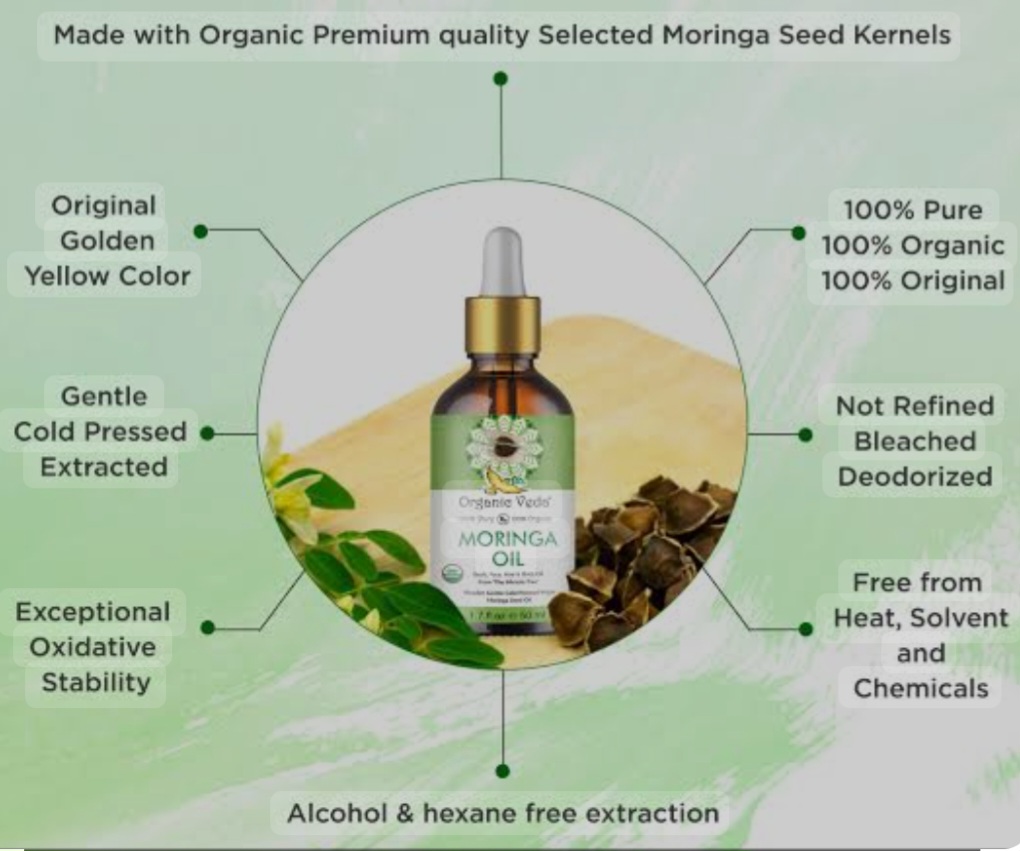
39. M. oleifera as a promising anti-obesity agent. Various in-vitro findings suggest that supplements of M. oleifera cause direct inhibition of pancreatic lipase, thus reducing the conversion of triglycerides into simple. Moringa has fat storage regulation by upregulation of lipolysis-associated protein and down-regulating the expression of protein related to fat storage. It is also effective in the improvement of antioxidant levels. Besides these, Moringa is also responsible for increasing ghrelin levels and decreasing leptin, producing a feeling of satiety.
40. The leaves of the plant extract have been shown to be effective against the venom of Naja Nigricollis (a snake species) in rats. This snake’s venom contains potent neurotoxins that cause the degradation of phospholipids at the plasma membrane, affecting the normal neurotransmission process and causing hemolysis and hemorrhage. The results showed that Moringa extract effectively cured acute anemia, and a remarkable increase in micronucleated polychromatic erythrocytes was observed in rats treated with M. oleifera.
41. M. oleifera play a significant role as an anti-asthmatic agent. A research reported that moringa seed kernels can be used to treat symptoms of bronchial asthma. The study indicate that symptoms and respiratory functions decreased with the use of M. oleifera seeds. Therefore, it can effectively treat bronchial asthma .
42. Suppositories containing Moringa seed oil showed effective results against hemorrhoids. The incorporation of seed oil in suppositories reduced their melting point.
43. Moringa is widely used in livestock, poultry, and fish production.
44. The extract of M. oleifera leaves was helpful in eliminating the adverse effects of neem oil, which is used in aquaculture as an insecticide to control predators and parasites of fish fry. The researchers concluded that the extract of M. oleifera leaves eliminated the oxidative stress and toxicity caused by neem oil.
45. M. oleifera is rich in macronutrients and micronutrients, vitamins, phytohormones, alkaloids, and flavonoids, which make this plant a multipurpose plant. Recent research has shown that Moringa extract is also helpful in tolerance to abiotic and biotic stress under stressful environmental conditions.
46. Moringa is known for a number of non-medicinal uses, chief among which is its use for poultry, especially in curing viral infections (Newcastle Disease Virus) and other parasitic and bacterial diseases that cause mortality in animals .
47. The plant also serves as an important growth promoter for farmers in the production of tomatoes, peanuts, corn, and wheat in their early vegetative stages.
48. It is also used for production of environmentally friendly biopesticides, which is cheap and easily available and helps in curing various plant diseases .
49. Studies have shown that the total crop production increased by 20–35% by using M. oleifera leaf extract, which is a good sign for increasing agricultural growth at a minimal cost.
50. The aqueous extract of M. oleifera is a source of various minerals and growth promoters (indole acetic acid, gibberellins, cytokines).
51. It can be used as an effective plant biostimulant that could be a simple alternative to the artificial fertilizers and pesticides available in the market.
The methanolic extract of the plant is found to be rich in potassium, calcium, carotenoid, phenols, and zeatin, and when three sprays of this extract are applied on the oilseed rape plant, it is observed that the pods, twigs, height, and number of seeds increase significantly compared to the untreated control group.
52. The ability of the plant to resist drought is due to the plant hormone “zeatin”, which is present in large quantities in the methanolic extract, so the plants exposed to such climatic conditions when sprayed with the methanolic extract of Moringa showed improved growth characteristics compared with well-watered plants.
53. The tree is efficient in removing water hardness and is used by African tribes as a cheap source compared to chemical softeners. Previous reports indicated that a water sample treated with M. oleifera seeds reduced the hardness content of the water by 50–70%, which used to be 80.3 g L−1 CaCO3.
54. A study conducted by several groups found that treating river water in African countries with Moringa seeds reduced colour and microorganisms by 90% and microorganism (Escherichia coli) levels by up to 95%.
55. M. oleifera seed extracts has also been shown to be an effective solution for treating turbidity, alkalinity, and dissolved organic carbon. It is suggested that Moringa could be, to some extent, an alternative to chemical alum used to remove water turbidity .
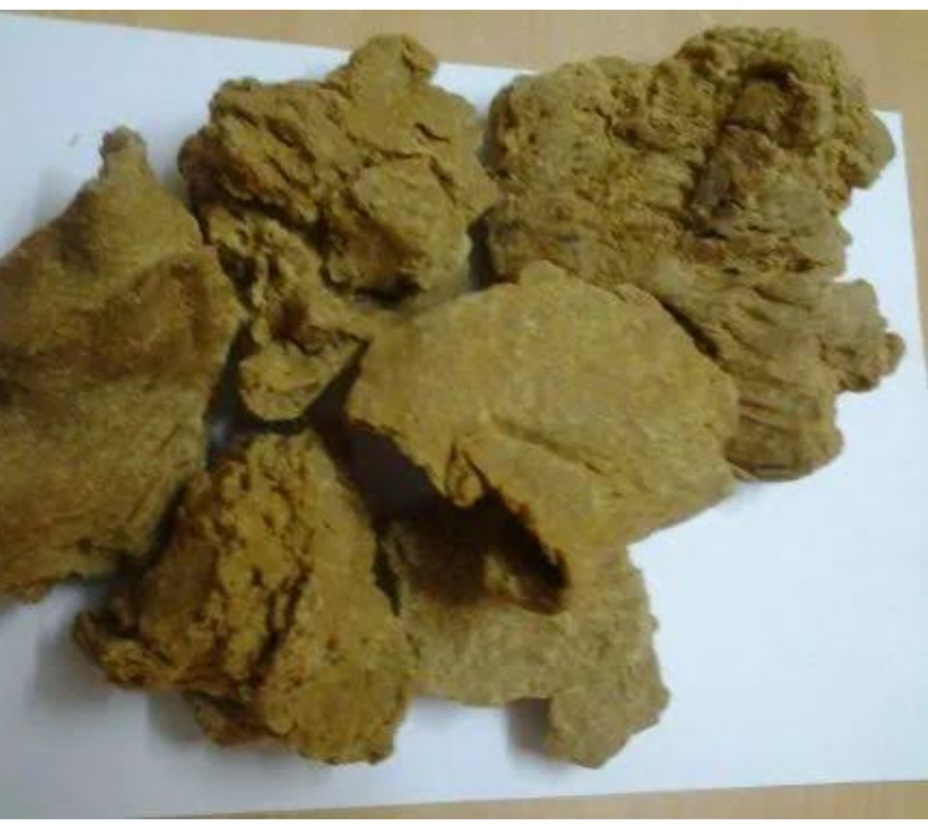
56. Moringa is a good source for curing plant diseases and can be a good option for biopesticides. Since various plant pathogens affect the plants, Pythium debaryanum-a pathogen responsible for damping-off disease-can be cured by adding leaves to the soil.
57. Nearly all plant part (fruits, flowers, leaves, seeds, roots) is believed to have different properties that can heal the body spiritually and psychologically .
58. Early research shows that adding fresh moringa leaves to food for 3 months improves menopausal symptoms such as hot flashes and sleeping problems in healthy, postmenopausal women.
59. The powder resulting from grinding dried leaves of Moringa oleifera can be sprinkled over smoothies, yogurt, oatmeal, or soups, to enrich the nutrients in the meals.
60. Moringa oil has various industrial applications. It is used in the perfume industry, as it readily retains its fragrance and is not prone to rancidity, and in the manufacture of paints and lubricants. The oil is also used as a biodiesel feedstock.
SIDE EFFECTS OF MORINGA
1. Breast-feeding. Research regarding the effects of moringa for increasing breast milk production is mixed. Some early research shows that moringa increases milk production after one week of use, while other early research shows no benefit. It is also not clear if moringa is beneficial when used for longer periods of time.
2. Vitamin A deficiency. Early research shows that adding moringa powder to infant cereal does not improve vitamin A levels in infants with low levels of vitamin A.
3. When taken by mouth: Moringa is likely safe when the leaves, fruit, and seeds are eaten as food. Moringa leaf and seeds are possibly safe when used as medicine, short term. Products containing moringa leaf have been used for up to 6 months. Products containing moringa seed have been used for up to 3 weeks. Moringa root and root bark are possibly unsafe. The roots and root bark contain toxic substances.
4. Pregnancy: It is possibly safe to use moringa leaves in pregnancy during the second or third trimester. But it’s possibly unsafe to use the root, bark, or flowers of moringa when pregnant. Chemicals in the root, bark, and flowers might make the uterus contract. In traditional medicine, the root and bark were used to cause miscarriages. There is not enough reliable information to know if other parts of moringa are safe to use when pregnant. Stay on the safe side and avoid use.
5. Breast-feeding: Moringa leaf is possibly safe to use while breastfeeding for up to 4 months. There is not enough reliable information to know if other parts of moringa are safe to use when breast-feeding. Stay on the safe side and avoid use.
6. Hypothyroidism: Using moringa might make this condition worse.
7. Some medications are changed and broken down by the liver. Moringa might change how quickly the liver breaks down these medications. This could change the effects and side effects of these medications. For example,
a. Cytochrome P450 3A4 (CYP3A4) substrates interacts with moringa.
b. Levothyroxine (Synthroid, others) interacts with MORINGA. Moringa might decrease how much levothyroxine the body absorbs. Taking moringa along with levothyroxine might decrease the effects of levothyroxine.
c. Medications moved by pumps in cells (P-glycoprotein substrates) interacts with moringa. Some medications are moved in and out of cells by pumps. Moringa might change how these pumps work and change how much medication stays in the body. In some cases, this might change the effects and side effects of a medication.
d. Medications for diabetes (Antidiabetes drugs) interacts with moringa. Moringa might lower blood sugar levels. Taking moringa along with diabetes medications might cause blood sugar to drop too low. Monitor your blood sugar closely.
e. Medications changed by the liver (Cytochrome P450 1A2 (CYP1A2) substrates) interacts with moringa. Some medications are changed and broken down by the liver. Moringa might change how quickly the liver breaks down these medications. This could change the effects and side effects of these medications.
8. Feeding moringa leaves to poultry, pigs and fish is advantageous but only in limited amounts due to the presence of fibre and antinutritional factors.
9. Moringa oil seed cake, the by-product of oil extraction, is not very palatable to livestock and mainly used as green manure or a flocculating agent in water purification. Moringa seeds appear to be toxic to rabbits.
As moringa is available in supplements, powders or extracts, which can be taken orally on daily basis, it is important to consult our healthcare provider to find out what dose might be best for a specific condition.
GROWTH REQUIREMENT
CLIMATIC REQUIREMENT:
M. oleifera is widely distributed worldwide . It requires tropical and subtropical climate. It grows at a temperature of about 25–35 °C. It grows best in indirect sunlight and without waterlogging. It does not tolerate waterlogged conditions due to heavy rain. A location that receives at least 6-8 hours of direct sunlight daily is required.
SOIL REQUIREMENT: The tree grows rapidly in loamy and well-drained sandy soils, preferring a height of 500 m above sea level. The soil should be slightly acidic to alkaline. That is pH range of 6.3 to 7.0.
The tree begins to bear fruit at 6 to 8 months of age but due to different soil conditions in the producing countries, the nutrient content varies from country to country.
WIND: moringa trees are not wind-resistant. The plant should be grown in a protected area and pruned regularly so that it may cope a bit with any stronger winds. The seedlings can be surrounded with a wire mesh, for protection against wind and as a support for the shade net.
PROPAGATION
BY SEEDS: If seeds are to be used for propagation, soak the seeds in water for a day and then plant them at a depth of around 1 cm. Make sure the temperature is at least 20°C, or use a heat mat.
BY CUTTINGS: Branch cutting can also be used for vegetative propagation. The cuttings from the mother tree should be covered with sealant.
SEED INOCULATION: Moringa seedling at planting can be inoculated with a beneficial mycorrhizae cocktail to aid its growth.
PLANTING
SEEDLINGS: transplant seedlings when they are about 15-20cm tall. Space the plants 2-3 meters apart to allow sufficient room for growth. Moringa roots are tuberous and extremely fragile, therefore, extra care must be taken not to damage the root when transplanting.
PLANTING TIME: The seedlings can be planted only when temperatures are above 15°C, even in full sun with adequate watering. They require a warm weather condition.
WATERING
In the nursery, seeds should be watered regularly until the seedlings are established. Ensure the soil remains moist but not waterlogged. A 20cm seedling will need around 4 liters of water per day, evenly distributed around the tree. The first month is critical until the moringa seedlings become woody.
ESTABLISHED TREES: Moringa is drought-tolerant. Water sparingly and allow the soil to dry out between waterings. Please note that if you want to harvest leaves, moringa needs to be watered especially during the dry season.
FERTILIZATION
Once a year, especiallyduring the offseasons, apply compost around the drip line or manure. Moringa trees can grow in low fertile soils, but if farmers want them to grow fast and provide lots of leaves and pods, they need rich soil.
MAINTENANCE / PRUNING
Formative pruning: prune young trees to encourage a strong structure. Remove lower branches and shape the canopy. In windy areas, ensure that the moringa stays compact, as it is very sensitive to wind.
On regular basis, trim the tree to maintain a manageable size and to encourage bushy growth, which increases leaf production. If big branches are cut, use a tree sealer to cover the cut surface. Always disinfect the pruning shears before pruning.
PEST AND DISEASE MANAGEMENT
Disease resistance: moringa is generally disease-resistant. Ensure good air circulation and avoid water logging to prevent fungal infections.
HARVESTING
LEAVES: The leaf harvest can begin in the first year. Harvest leaves when they are young and tender. Regular harvesting encourages new growth.
PODS: pick pods when they are very young and green for vegetable use. Mature pods can be left to dry for seed collection.
In conclusion, more researches are still being carried out on M. oleifera worldwide. The above benefits had stated few of its ethnopharmacology properties, pharmacology activities, phytochemistry, phytopharmaceutical formulations, clinical studies and toxicological properties. The plant is a rich source of alkaloids, phenolic acid, glycosides, sterols, glucosinolates, flavonoids, terpenes ,fatty acids and other compounds beneficial to human health and livestock. In addition, M. oleifera is also rich in compounds such as vitamins, micronutrients, and carotenoids which increase its medicinal value and consumption as a superfood. Pharmacological studies show that the active constituents of the plant have effectively cured various diseases such as neuropathic pain, cancer, hypertension, diabetes, obesity etc.
As new diseases begin to rampage the world health conditons, more investigation are needed to be carried out to determine the efficacy of the plant as a source of medication in treating the life-threatening diseases such as coronavirus outbreaks, Acquired Immunodeficiency Syndrome (AIDS), various cancers and other life- treatning illnesses.
